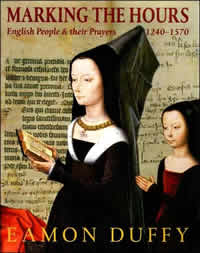Book Notes
 Eamon Duffy, Marking the Hours; English People and Their Prayers, 1240–1570 (New Haven: Yale, 2006), 202pp.
Eamon Duffy, Marking the Hours; English People and Their Prayers, 1240–1570 (New Haven: Yale, 2006), 202pp.
This book is too expensive to buy, but it is very much worth the effort to track down at your public or local seminary library. Eamon Duffy is a self-described "cradle Catholic," Professor of the history of Christianity at the University of Cambridge, and former president of Magdalene College. In this handsome volume of text and images (114 photographs of manuscripts) he explores the distinctly Catholic personal prayer books called Book of Hours that were a glamorous centerpiece of medieval piety. Books of Hours were used by lay people, not clergy. Their content varied, but typically included the offices or hours of daily prayers, psalms, hymns, devotions, and, as they were handed down from generation to generation, handwritten marginalia. It is to these marginal "scribbles" that Duffy pays special attention (and thus the delightful double entendre of the title).
Most studies of the 800 surviving manuscripts (and even more printed copies) consider the Books of Hours as artistic artifacts, which they certainly are given their elaborate and brightly colored illustrations. But Duffy's interests are distinctly historical, theological, liturgical and personal. Who owned these books, and how did they use them? What do we learn about the history of prayer, and the relationship of private piety to the church institution? Women, it turns out, were significant owner-users, as were the aristocracy in general (who could read the Latin). But cheaper versions emerged, in vernacular English, especially with the advent of print, and so Books of Hours flourished in a down-market audience of modest means. At the end of the fifteenth century, in fact, "Books of Hours became, in terms of numbers of editions, quite simply and without any rival, the chief product of the new technology" [of printing]. Printing tended to standardize content and offer a broader range of quality and price.
Some scholars have argued that Books of Hours hastened a "regrettable" privatization of piety, and encouraged an ego-centric spirituality of "me-prayers" that was proto-Protestant. Duffy rejects this idea of a new individualism or interiority. True, these books were used by individuals, but they were people deeply embedded in their communities of family, guild, and church. By 1534 and England's break with Rome, Books of Hours became illegal, and a "battleground" and target of Protestant reformers who detested their popery, indulgences, Mariology, and prayers for the dead. For detractors a Book of Hours symbolized papist error at its worst. For die-hard Catholics, they became "a badge of non-compliance with the Reformation." Thanks to Duffy's meticulous research, they speak to us even today of the soul's search for God.


